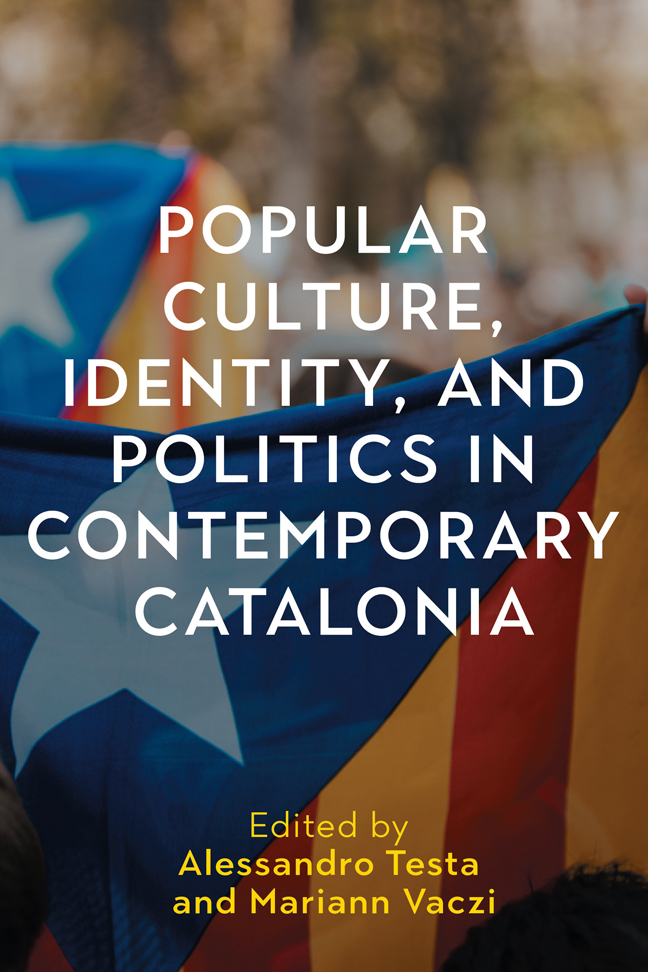Book contents
- Frontmatter
- Contents
- List of Illustrations
- List of Contributors
- Introduction: Culture, Identity, and Politics in Contemporary Catalonia
- 1 Castells, Myths, and Allegories of Nation-Building
- 2 The Ritual Making of Central Catalonia 1: National Identity and the Hanging of the Donkey
- 3 The Ritual Making of Central Catalonia 2: Comparses and the Dynamics of Inclusive Nationalism
- 4 Reclaiming the Cathar Past: At the Crossroads between Identity Politics and Tourist Economies in Catalonia
- 5 The Heritage of the Humiliated: Popular Resistance in Defense of the “Bous” in the Lands of the Ebro
- 6 Communities without Festivities? Community Effects, Transformations, and Conflicts after Covid-19 in Catalonia
- 7 Bon Profit! Food as National Identity in Catalonia
- Afterword: Beneath the Nation: Collective Creation and Civic Need
- Bibliography
- Index
3 - The Ritual Making of Central Catalonia 2: Comparses and the Dynamics of Inclusive Nationalism
Published online by Cambridge University Press: 02 March 2024
- Frontmatter
- Contents
- List of Illustrations
- List of Contributors
- Introduction: Culture, Identity, and Politics in Contemporary Catalonia
- 1 Castells, Myths, and Allegories of Nation-Building
- 2 The Ritual Making of Central Catalonia 1: National Identity and the Hanging of the Donkey
- 3 The Ritual Making of Central Catalonia 2: Comparses and the Dynamics of Inclusive Nationalism
- 4 Reclaiming the Cathar Past: At the Crossroads between Identity Politics and Tourist Economies in Catalonia
- 5 The Heritage of the Humiliated: Popular Resistance in Defense of the “Bous” in the Lands of the Ebro
- 6 Communities without Festivities? Community Effects, Transformations, and Conflicts after Covid-19 in Catalonia
- 7 Bon Profit! Food as National Identity in Catalonia
- Afterword: Beneath the Nation: Collective Creation and Civic Need
- Bibliography
- Index
Summary
The previous chapter, ‘The Ritual Making of Central Catalonia 1: National Identity and the Hanging of the Donkey’, demonstrates the social relevance of Solsona's main public ritual, el Carnaval, within the borders of the city, of its comarca, and of central Catalonia as a whole, describing and analysing the main characteristics of both municipality and festivity. Among these, little attention has been devoted to a feature that, however, bears a primary importance in the economy of the festival as well as in the entire local society: the colles and comparses.
COLLES AND COMPARSES: DESCRIPTION AND ANALYSIS
A comparsa is essentially a group of people (both colla and comparsa are roughly translatable as ‘group’, ‘gang’, or ‘team’). What distinguishes at first sight a normal group of people from a comparsa is the fact that the members of the latter each wear the same ‘bata’, which is a colourful uniform used mandatorily during the carnival and exclusively (or almost so) during festive occasions. The fact of appearing associated by a uniform is reflected in the etymology of the name, which comes from ‘comparèixer’ (‘to appear’, cfr. Latin comparere, Italian comparire). Solsona's Carnival is the realm of some 60 comparses populated by some 10,000 people ‘portant bata’ (‘wearing a bata’). The comparses reign supreme and undisputed over every aspect of the festival, and probably represent one of the most striking post-Francoist developments in the history of the Carnival, and in fact in the recent history of the social configuration of Solsona altogether. Many informants have often insisted that the comparses are the ‘essencia’ (‘essènce’) of Solsona's Carnival; the author Noemi Vilaseca, in her illustrated book about the Carnival of Solsona, calls them the ‘ànima viva del Carnaval’, ‘the living soul of the Carnival’ (Vilaseca and Trilla 2011, 116). This folk ontology of Carnival is of paramount importance, as we shall see, whereby locals and strangers alike build that sense of typicity and authenticity that is then reflected on the local communities themselves, becoming symbolic material for the construction of social meaning and collective belonging.
- Type
- Chapter
- Information
- Publisher: Boydell & BrewerPrint publication year: 2023



